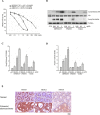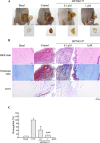Anticancer activity of MPT0G157, a derivative of indolylbenzenesulfonamide, inhibits tumor growth and angiogenesis
- PMID: 26087180
- PMCID: PMC4621912
- DOI: 10.18632/oncotarget.4068
Anticancer activity of MPT0G157, a derivative of indolylbenzenesulfonamide, inhibits tumor growth and angiogenesis
Abstract
Histone deacetylases (HDACs) display multifaceted functions by coordinating the interaction of signal pathways with chromatin structure remodeling and the activation of non-histone proteins; these epigenetic regulations play an important role during malignancy progression. HDAC inhibition shows promise as a new strategy for cancer therapy; three HDAC inhibitors have been approved. We previously reported that N-hydroxy-3-{4-[2-(2-methyl-1H-indol-3-yl)-ethylsulfamoyl]-phenyl}-acrylamide (MPT0G157), a novel indole-3-ethylsulfamoylphenylacrylamide compound, demonstrated potent HDAC inhibition and anti-inflammatory effects. In this study, we evaluated its anti-cancer activity in vitro and in vivo. MPT0G157 treatment significantly inhibited different tumor growth at submicromolar concentration and was particularly potent in human colorectal cancer (HCT116) cells. Apoptosis and inhibited HDACs activity induced by MPT0G157 was more potent than that by the marketed drugs PXD101 (Belinostat) and SAHA (Vorinostat). In an in vivo model, MPT0G157 markedly inhibited HCT116 xenograft tumor volume and reduced matrigel-induced angiogenesis. The anti-angiogenetic effect of MPT0G157 was found to increase the hyperacetylation of heat shock protein 90 (Hsp90) and promote hypoxia-inducible factor-1α (HIF-1α) degradation followed by down-regulation of vascular endothelial growth factor (VEGF) expression. Our results demonstrate that MPT0G157 has potential as a new drug candidate for cancer therapy.
Keywords: HDAC; HIF-1α; Hsp90; angiogenesis; tumor microenvironment.
Conflict of interest statement
The authors declare no conflicts of interest.
Figures







References
-
- Taddei ML, Giannoni E, Comito G, Chiarugi P. Microenvironment and tumor cell plasticity: An easy way out. Cancer Lett. 2013;341:80–96. - PubMed
-
- Ferlay J, Shih HR, Bray F, Forman D, Mathers C, Parkin DM. Estimates of worldwide burden of cancer in 2008: GLOBOCAN 2008. Int J Cancer. 2010;127:2893–2917. - PubMed
Publication types
MeSH terms
Substances
LinkOut - more resources
Full Text Sources
Other Literature Sources

